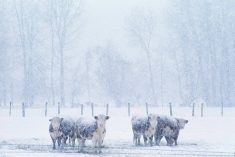Cattle prices for the most part stayed firm at sales across Manitoba last week. In some places, though, feeders were sold at a higher price than the previous week.
“Most animals were (worth) $2 to $5 (more) than the week before and that followed a week where the futures board went up every day. Then the cash market will follow that,” Allan Munroe of Killarney Auction Mart said.
In the Chicago futures market on Jan. 29, quotes for live cattle remained firm compared to the previous week, showing changes of less than one per cent and ranging from US$116.30 to US$132.75 per hundredweight. Meanwhile, Chicago feeder cattle futures showed a 1.3 to 2.6 per cent loss, with quotes starting at US$140.25 and going up to US$151.225/cwt.
Read Also

Canadian canola prices hinge on rain forecast
Canola markets took a good hit during the week ending July 11, 2025, on the thought that the Canadian crop will yield well despite dry weather.
Of feed grain prices, Munroe said corn and barley “have gone up significantly since the new year.”
“When the price of grain goes up, (the price of) feeder cattle goes down. Maybe the corn and barley have stabilized (lately), and we love stability. That’s where we start seeing a little bit of a flood in the cattle market.”
High-delivered bids for feed barley have run from $5.10 to $6.75 per bushel, according to Prairie Ag Hotwire data from Jan. 28, up by between 81 cents and $1.70 on the year. At the same time, feed wheat has traded between $6.75 and $8.30/bu., up $1.40-$1.91 from the year before.
Cattle producers have had sufficient amounts of corn and cereal silage, Munroe said, adding he doesn’t expect feed and forage supplies to become an issue in the near future.
Munroe said he also expects more cattle to make their way east as production at Cargill’s beef-packing plant at Guelph, Ont. ramps back up. The plant was shut down Dec. 17-29 after workers tested positive for COVID-19. Operations at the facility resumed earlier this month.
“More cattle (are) starting to go east into Ontario and they tend to take the higher-end, top-quality calves, steer calves especially, as opposed to other places,” he said.
As for exports to the U.S., Munroe expects most Canadian cattle to stay north of the border.
“Our market tends to be higher than theirs, and until it gets down to a level where they can buy our cattle the same or cheaper than they can buy their own, they stay up here.”




















